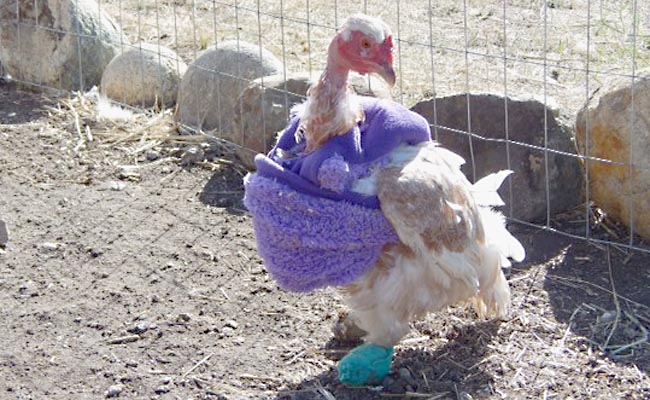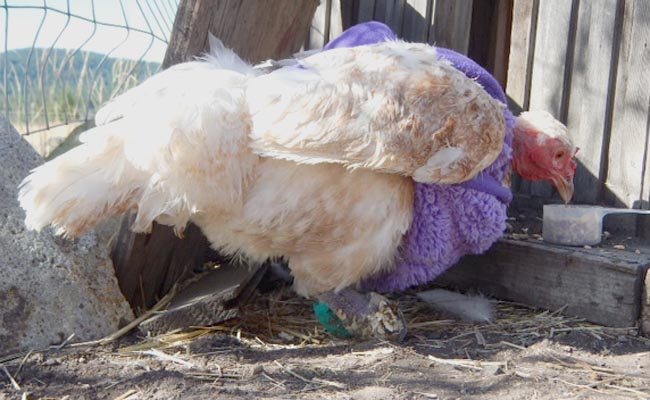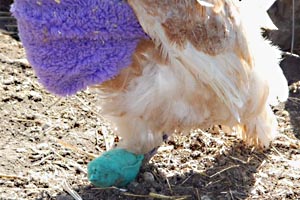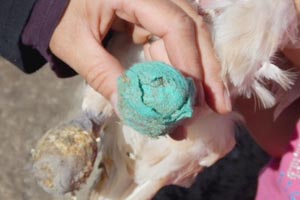
By Michele Young
Temperatures had plummeted below normal for several days in a row in winter of 2013. Tracy Reynolds crossed the yard of her Campbell Range acreage on the southeast edge of Kamloops to check on her flock of chickens. She grew more concerned with each step when she noticed a soft bump on the cold, hard ground outside the coop.
The bump was Ned, a turken hen, who had been breathing with difficulty the last few days. Ned wasn’t moving.
“It was —20C one day and she was sitting out, just hunched over,” Reynolds said.
Ned was alive, but she wasn’t in good shape.

Four years ago, Tracy Reynolds decided it was time to get her own backyard chickens. She didn’t like the way the birds were commercially raised in crowded barns, with no way to get outside and scratch around in the dirt as they would naturally.
So she built a chicken coop, painted it deep red to match the house, fenced it in and started collecting chickens (and a turkey or two).
Among the eggs she hatched were a couple of turken chickens; aesthetically, they’re rather ugly, with the bare skin exposed along their necks and stomaches — featherless, pink and wrinkled.
Despite their unbecoming looks, Reynolds was soon smitten by her collection of birds.
“I had no idea how much personality chickens have,” she said. “They’re such good parents.”
Her children, Jackson and Helena Schuler, took to treating the birds like pets, picking them up and cuddling them, so the chickens were as tame as dogs. The kids passed hours in the coop.
The kids named most of the chickens, but it was Reynolds who was responsible for giving a turken hen the masculine name Ned. It flowed off the tongue with the phrase “nearly naked Ned” for the bird’s exposed pink neck, she explained.
By eight months, Ned was turning out to be quite a beauty, at least by turken standards. She won first place in the “best of all other breeds” in the Barriere Fall Fair, netting her owners $10. Chicken scratch to some, but an early indication that Ned was, somehow, different.

When Reynolds found Ned huddled on the ground, the chicken was rasping as she breathed — probably from a respiratory infection — and her feet were hobbled by frostbite.
Reynolds didn’t want to go to extraordinary means to save Ned; if the chicken was meant to go, then so be it. She would take her into the house and see how she did.
Ned fought back. She got over the respiratory infection and returned to health. Except for her feet.
“It looked like a burn. I wrapped them to keep them clean,” said Reynolds.
First the skin peeled, then the feet turned black, and after a few months, both appendages had fallen off. Ned showed no signs of pain; she just kept clucking happily in her warm winter home.
“She didn’t feel it. I thought she must have nerve damage,” said Reynolds.
The only time Ned seemed to be hurting was when her leg stumps were raw; Ned didn’t move much until they healed over.
Despite the bird’s recovery, Reynolds seriously considered sending Ned to that big chicken coop in the sky because how can a chicken get by without feet? But even her husband Greg Schuler tried to convince her to save the turken.
“Even my husband said she looks happy. . . . A lot of people think why would you do that, but when you meet her — she’s just got the nicest personality,” she said.
“I had that moment. . . . My husband said ‘She seems to be fine’ and the kids said ’No, you can’t.’”
She couldn’t and she didn’t.
There was no way Ned was going to get around on her stumps. Reynolds, who worked at the Vancouver Aquarium before coming to Kamloops where she’s now at the B.C. Wildlife Park, contacted a veterinarian friend and they got creative.
Ned’s stumps were wrapped with a layer of cotton, then Reynolds used the end of a plastic syringe to provide some support and protection. Over that, she spun layers of coloured veterinary wrap until Ned’s ‘feet’ were two rounded orbs that she could pivot on.
Ned the naked neck chicken became newly mobile.
She returned to her coop mates and the pecking order therein. Ned did what she’d always done; she stood up to the chickens she didn’t like, she hung out with her friends, she laid eggs (often in the dog kennel), she hatched chicks.
“She was always doing well emotionally,” said Reynolds.
When Ned’s new feet got too wet or too dirty, Reynolds changed the wrapping. And when it got cold, she wrapped Ned in a sweater (a redesigned purple fleece toque) or took the chicken into the house. Ned now winters in Reynolds’s pottery studio or with the family.
“Honestly, I just keep her inside. Because of the frostbite, she gets cold easily,” said Reynolds.
“She’ll happily sit on your lap all evening watching TV.”
A while ago, Ned did get an infection and Reynolds got some antibiotics to help the chicken back to health — something she didn’t do when Ned was at death’s door two years ago.
“We didn’t come this far to lose her now,” Reynolds admitted.

As the nip of fall air hovers around the acreage, Ned the chicken is in with the other poultry, hanging around with an old Silky rooster, Fluffernuts. The two flock together in their own part of the coop.
When the temperature drops, though, Ned will be back in the house, leaving Fluffernuts on his own in the coop with the other birds and the heat lamp. She might be ugly to some, but that fancy-footed flightless fowl is now family.
“It’s just her winning personality. Nothing phases her,” said Reynolds.
* * * * *
Of course, Ned the chicken has her own Facebook page. Check out more photos, videos and updates at: https://www.facebook.com/Nedtheturkenchicken?fref=ts
